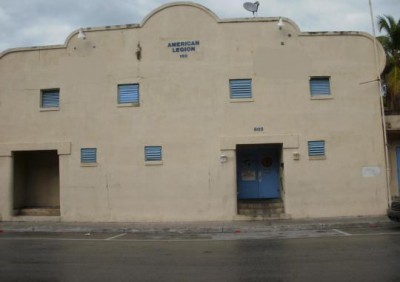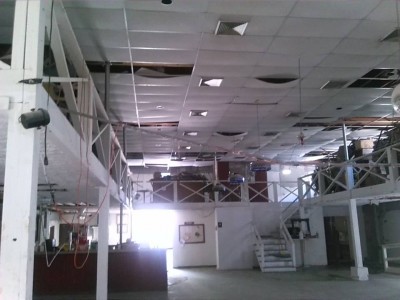American Legion Post 168 Structural Stabilization Project Nears Completion
City Planner Don Craig expressed some concern.
“Planning staff and the Historic Architectural Review Committee recommended against this,” Craig said of the listing.
“We were fearful and still remain fearful that the unsafe nature of the building cannot be remedied, and may result in the entire — if not the majority — of the building being removed or replaced.
And once you move to replace the historic building, it is no longer historic.”
Key West Citizen, 7/1/12. J. Desantis
~~~~
After World War II many Key Westers who served in the military around the world came back home and resumed the lives they had left behind, with an appreciation of how things were in the larger world.
Key West veterans organizations formed after WW I were already in place. Many of the returning WW II vets turned to organizations like the American Legion and the Veterans of Foreign Wars as means of staying in touch with their fellow soldiers, sailors and Marines, and to share their service with their older relatives, fathers and mothers, uncles and aunts.
Key West in the post war years and through most of the 1950’s was, like most of the south, a segregated place. There were black schools, black churches, black neighborhoods — and black veterans organizations. Even Key West City Hall on Angela Street, built in the 1950s, had segregated bathrooms and separate drinking fountains.
So it seemed natural back then for black and white veterans to gather in their separate posts. Certainly it wasn’t right, but that’s how it was in those times.
There was a white American Legion, Arthur Sawyer Post 28, and a white VFW, Post 3911, called the Southernmost Post. The black American Legion William Weech Post 168 and the black Walter Mickens VFW Post 6021 joined together in 1952, obtained some land, and raised money for materials to build a permanent Post home in Bahama Village on Emma Street, across from the Frederick Douglass School complex.
Many of these veterans had gained construction experience either in the military or as civilian employees of the Navy Yard, located just one block from where the post was built. They built a large hall with room for Post meetings and for social events and for entertainment. It soon became a center point for social gatherings — weddings, birthdays and funerals. The hall was also used to host stage and musical performances, and for dances.
But time takes its toll on buildings, just as it does on people. By late in the first decade of the 21st century many in the community began to realize that the building was in need of some serious maintenance if it was to remain viable. Time had also taken a toll on membership on fraternal organizations generally and the two black posts in particular. Membership in the two Bahama Village vets posts dwindled to only a few members. Veterans of the Vietnam era and later conflicts didn’t have the same enthusiasm for fraternal organizations as their older kin. It became easier for the Posts’ officers to put control of the Posts’ building into the hands of a manager who could rent the hall out for occasional events and open the bar for a few hours every day for the people who found it a friendly place to enjoy some alcohol-fueld conversations. There simply wasn’t enough money coming in to do anything except pay for utilities and a few minor repairs.
In 2012 the city, taking note of a piece of concrete that fell from the building parapet on the sidewalk below, examined the building, declared that it was unsafe for use, and ordered it closed. An initial grant from the Bahama Village TIF board was used to prepare plans for restoration and renovation. A local architect did that but two groups of citizens began to squabble over what could and should be done.
Local preservation architect Bert Bender then proposed a different approach that would stabilize the structure of the building but not provide for the full renovation. This was a first step to forestalling demolition of the historic structure. Another application was made to secure funds for repairs from the Bahama Village TIF, which by this time was under control of the Bahama Village Redevelopment Advisory Committee, led by City staff, principally the Planning Department and Assistant City Manager for Administration Mark Finigan. (Finigan resigned his position earlier this year; his position has been advertised as available.)
Meanwhile a small group of residents with a family history of membership in one or both of the organizations came together and tried to bridge the divide that arose. The organization was awarded a grant from the TIF board to begin the work that would be necessary to restore the clubhouse to use. These citizens also managed to secure designation of the building as an historic building on the National Register of Historic Places.
The stabilization project is now well underway and should be completed within the next 2-3 months. There is also some interior work being carried out [see the photo below].
“So, never doubt that a small group of thoughtful, committed citizens can change the world; indeed, it’s the only thing that ever has.”
— Margaret Mead
~~~~~~~~~
 Bob Kelly is a retired computer company executive who moved to Key West in 1999 with his wife Janet. They live aboard a houseboat at City Marina at Garrison Bight. He is an early graduate from the city Ambassador program. He was a member of the board of directors of the Bahama Conch Community Land Trust and also the Bahama Village Music Program. He also served briefly on the Truman Waterfront Advisory Board before being removed on a technicality.
Bob Kelly is a retired computer company executive who moved to Key West in 1999 with his wife Janet. They live aboard a houseboat at City Marina at Garrison Bight. He is an early graduate from the city Ambassador program. He was a member of the board of directors of the Bahama Conch Community Land Trust and also the Bahama Village Music Program. He also served briefly on the Truman Waterfront Advisory Board before being removed on a technicality.

